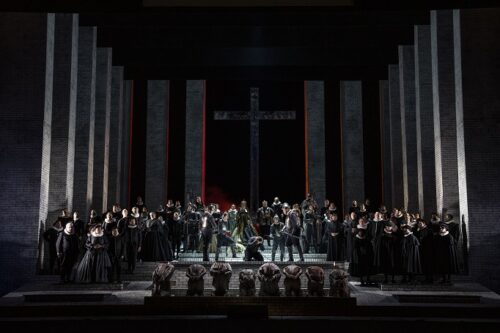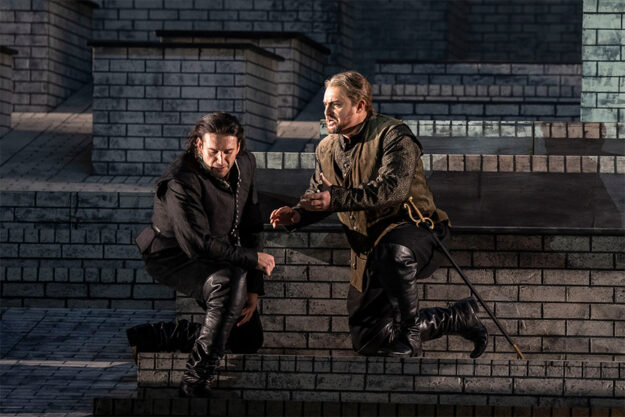 United States Verdi, Don Carlos: Soloists, Chorus and Orchestra of Lyric Opera of Chicago / Enrique Mazzola (conductor). Civic Opera House, Chicago, 25.11.2022. (JLZ)
United States Verdi, Don Carlos: Soloists, Chorus and Orchestra of Lyric Opera of Chicago / Enrique Mazzola (conductor). Civic Opera House, Chicago, 25.11.2022. (JLZ)

Production:
Original Director – Sir David McVicar
Revival Director – Axel Weidauer
Sets – Robert Jones
Costumes – Brigitte Reiffenstuel
Revival Lighting – Jan Hartmann
Revival Choreographer – August Tye
Fight director – Chuck Coyl
Chorus master – Michael Black
Cast:
Carlos – Joshua Guerrero
Thibault – Denis Vélez
Elisabeth – Rachel Willis-Sørensen
Count of Lerma – Laureano Quant
Monk – Peixin Chen
Rodrigue – Igor Golovatenko
Eboli – Clémentine Margaine
Philippe II – Dmitri Belossselskly
Royal Herald – Alejandro Luévanos
Voice from Above – Lindsey Reynolds
Grand Inquisitor – Soloman Howard
Much is made of the revisions to Verdi’s Don Carlos, particularly the five-act version in French that Lyric used here, and the options point to the continuing appeal of the opera. Within those choices, performers have the artistic space to make a production persuasive when they bring the score to modern audiences. While audiences at Lyric Opera of Chicago were accustomed to Don Carlo, the Italian version, this first staging of the French-language revision succeeded on many counts.
The production itself is a revival of the one Sir David McVicar designed for Oper Frankfurt. The set for all the acts is based on a series of white columns that serve various functions, and this efficient concept facilitates scene changes. While suggesting a pavilion in the forest of Fontainebleau, the addition of crosspieces and matching white bricks in Act II shifted it smoothly to the monastery. With the removal of Charles V’s tomb, the monastery interior suggested a chamber at Philippe’s court in the next act. This allowed for an almost uninterrupted flow between the first three acts. (The performance had a single intermission between Acts III and IV).
Unfortunately, the transition near the close of the opera was awkward: actors moved around the darkened stage while it was reset for the final scene. This interrupted the generally smooth flow and might be reconsidered if Lyric uses the production in a future season. If that were to occur, Lyric might also find a way to allow the Voice from Above (Lindsey Reynolds) at the end of Act III to be heard more clearly within the tableau.
Against the generally static white background, several details emerged, such as Eboli’s prominent use of a veil in her Act III scene with Carlos that connected the ‘Veil’ song in the previous act to the narrative. Yet it was odd to see the chandelier in the opening scene, when it belonged in the next act where it served as a censer above the tomb. It called attention to the impact that Charles V had on the plot, and also reinforced the voice that Verdi had given to the putatively deceased ruler in his score. These and other visual elements supported that text, which was sung with remarkable style.

The principals in the cast were equally strong interpreters of their roles. Tenor Joshua Guerrero conveyed his character’s style from the start, with the aria ‘Je l’ai vue’ setting the tone for the subsequent duet with Rachel Willis-Sørensen’s Elisabeth. Guerrero’s remarkably facile upper register allowed him to phrase passages with an ear toward the line. The full, supported sound was welcome in the exposed phrases that require such a talented and skilled musician to sound convincing. Guerrero brought similar passion to the scene with Igor Golovatenko as Rodrigue, the Marquis of Posa. In the duet ‘Dieu, tu semas dans nos âmes’, the two complemented each other, their voices blending with a similar, rounded tone. This continued later in their compelling farewell scene of Act IV.
The consistent approach Guerrero brought to the singing with Posa extended to his later scene with Clémentine Margaine’s Eboli. Here, the shock that Guerrero showed when Eboli confessed her love for him was as spontaneous as Golovatenko’s response earlier in the opera when he realizes that Carlos is in love with the queen. Margaine’s voice and acting combined to give the score dimensions that elicited a strong response – warm applause accompanied almost every number.
Dmitri Belossselskly gave a solid interpretation of Philippe II. While his voice sounded slightly hollow in his Act II entrance, he quickly warmed to the acoustics of the house with a rich and full bass. The soliloquy at the opening of the final act showed his keen approach to Verdi as it set up the fatal actions that would follow. With this work, the role of the Catholic Church takes on dimensions that challenge the tenets of mercy and forgiveness at the core of the faith, and Verdi embodied this in the role of the Grand Inquisitor. Bass Soloman Howard, resolute and threatening, brought the role to life. The lower pitches of his resonant voice brought a chill to the house in his famous duet with Belossselskly as they foresee the bodies that will need to be buried to maintain the status quo of the court and, indisputably, the Church.
In a similar way, Margaine was a multi-dimensional, stunning Eboli. Her interpretation of the familiar ‘Veil’ song was note-perfect and benefited from subtle pauses that made the piece seem fresh. Her ‘O don fatal’ almost stopped the action as the various threads of deception and betrayal merged musically and dramatically with consummate style. The full-bodied passion of a powerful woman thwarted by fate came alive on stage.
The powerful music-making continued, as Rachel Willis-Sørensen brought a comparable intensity to her farewell aria. She reinforced the elegiac elements of ‘Toi qui sus le néant’ with her graceful phrasing, thoughtful pauses and subtle dynamics. She made this familiar aria sound like chamber music, which helped to set up the ending. In the Italian version, the dénouement is ambiguous as Carlos is taken into the crypt when the members of the Inquisition come for him. Here, Carlos is executed onstage. As a result, the voice of the monk in the final bars takes on different dimensions. If nothing else, that moment at the conclusion helped everyone recall all the voices that made this production strong, especially those of Golovatenko and Guerrero.
Conductor Enrique Mazzola deserves credit for his convincing interpretation of the score, and for bringing out some of the subtle colors in this version. His tempos allowed the French to be heard distinctly over the full orchestration. In his hands various details and motives emerged, especially the friendship between Carlos and Rodrigue. The individual instrumental timbres that Verdi used in his scoring were not obscured, and it was good to see Mazzola recognizing various members of the orchestra at the end of the performance. Credit goes to Lyric Opera of Chicago for assembling a remarkable international cast and giving us a Don Carlos that will long be remembered.
James L. Zychowicz
